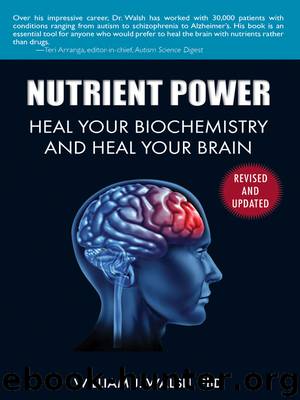Nutrient Power by PhD William J. Walsh

Author:PhD William J. Walsh [William J. Walsh, PhD]
Language: eng
Format: mobi
Publisher: Skyhorse Publishing
Published: 2014-04-01T00:00:00+00:00
Table 7-1.
Biochemical Features of Autism (partial list)
• Low levels of glutathione
• Undermethylation
• Elevated mercury, lead, and other toxins
• Copper overload and insufficient ceruloplasmin
• Zinc deficiency
• Vitamin A deficiency
• Elevated urine pyrroles
• Depressed metallothionein protein levels
• Elevated carboxyethylpyrroles
• Low levels of magnesium
• Deficiency of selenium and cysteine
Oxidative stress
While evaluating extensive blood and urine chemistries for thousands of ASD patients, I learned that more than 99% exhibit evidence of excessive oxidative stress.119 Chemical biomarkers for this condition include pervasive zinc deficiency; elevated pyrroles; low Cu/Zn SOD;129 copper overload; low ceruloplasmin; undermethylation; low levels of glutathione, selenium, and MT proteins; and elevated levels of mercury, lead, and other toxic metals. Recent research studies have heightened interest in this area, and many experts now believe that oxidative stress is central to the etiology of autism.
Examination of the popular biochemical therapies shown in Table 7-2 reveals that nearly all provide an antioxidant effect. For example, the most commonly prescribed drug for autism patients is Risperdal, which has antioxidant properties. Therapies to overcome hypomethylation result in more robust levels of the natural antioxidants glutathione, MT proteins, and cysteine. The GF/CF diet results in reduced inflammation, which lowers antioxidant requirements.
Many respected researchers and clinicians believe that mercury poisoning is the central problem in autism and use chelating chemicals that strip this toxin out of the body. Chelation is a standard medical procedure used by mainstream medicine for cases of severe lead or mercury poisoning. We encountered several cases of toxic metal poisoning in depressed patients, and we were very impressed by the rapid and permanent recoveries following four or five days of in-hospital chelation therapy. However, I’ve learned that chelation of children with autism usually presents a very different picture. In the late 1990s, we surveyed hundreds of families with an ASD child who had utilized chelation. In most cases, they reported very exciting improvements in their child during early stages of the therapy. Most parents said the improvements began to fade away after two to three weeks, with their child returning to the pretreatment condition. Many doctors concluded they needed to remove more mercury, and the 5-10 day chelation procedure was repeated. I met several families who had repeated this process more than 20 times over more than a year with the same result: definite improvement that faded away after about 17 days. It was clear to me that most of the excess mercury should have been removed after the first few chelations, and I concluded that the primary benefit was the powerful antioxidant effect of the chelating agent(s) rather than mercury removal. My chemical studies of thousands of children with autism revealed most to have high-normal levels of mercury but not mercury poisoning. High-normal toxic metal levels can result from weak antioxidant capability, without unusual mercury exposures. We did encounter a few autistic children with severe mercury poisoning, and a few weeks of oral DMSA chelation were administered to correct this problem.
Download
This site does not store any files on its server. We only index and link to content provided by other sites. Please contact the content providers to delete copyright contents if any and email us, we'll remove relevant links or contents immediately.
| Automotive | Engineering |
| Transportation |
Whiskies Galore by Ian Buxton(41937)
Introduction to Aircraft Design (Cambridge Aerospace Series) by John P. Fielding(33090)
Small Unmanned Fixed-wing Aircraft Design by Andrew J. Keane Andras Sobester James P. Scanlan & András Sóbester & James P. Scanlan(32763)
Craft Beer for the Homebrewer by Michael Agnew(18194)
Turbulence by E. J. Noyes(7977)
The Complete Stick Figure Physics Tutorials by Allen Sarah(7336)
Kaplan MCAT General Chemistry Review by Kaplan(6899)
The Thirst by Nesbo Jo(6877)
Bad Blood by John Carreyrou(6581)
Modelling of Convective Heat and Mass Transfer in Rotating Flows by Igor V. Shevchuk(6406)
Learning SQL by Alan Beaulieu(6237)
Weapons of Math Destruction by Cathy O'Neil(6213)
Man-made Catastrophes and Risk Information Concealment by Dmitry Chernov & Didier Sornette(5951)
Digital Minimalism by Cal Newport;(5700)
Life 3.0: Being Human in the Age of Artificial Intelligence by Tegmark Max(5509)
iGen by Jean M. Twenge(5384)
Secrets of Antigravity Propulsion: Tesla, UFOs, and Classified Aerospace Technology by Ph.D. Paul A. Laviolette(5332)
Design of Trajectory Optimization Approach for Space Maneuver Vehicle Skip Entry Problems by Runqi Chai & Al Savvaris & Antonios Tsourdos & Senchun Chai(5037)
Pale Blue Dot by Carl Sagan(4950)
